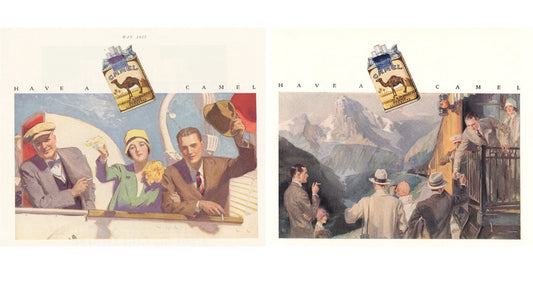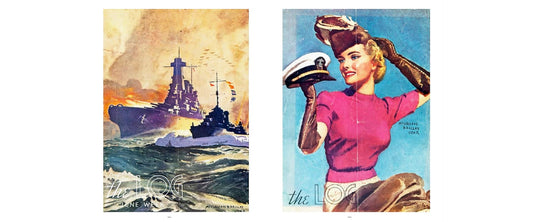
Sporting Life: Art, Athletes & Olympic Art Deco
Share
In a few weeks, the 2024 Olympic Games will begin in Paris. This will be the third time Paris will host one of the world’s largest sporting competitions. The first time the games were in Paris was in 1900, then again 100 years ago, in 1924.
For me, this is an exciting combination of sports and cultural events happening in the city where the Art Deco movement originated. It invites a look at the century of changes in sporting life, and allows me to shine a spotlight on some of the sports, art and athletes you may never have seen before.
Sport and spectacle
Both art and sport can excite and entertain. When combined, they have the power to inspire. The opening ceremonies of the Olympics take things to a grand scale. Performers put on a spectacular show welcoming teams in uniforms; inviting the world to watch.

This kind of excitement is captured on the September 1932 cover of Redbook magazine illustrated by New York based artist, McClelland Barclay (left and detail above).
That year, the 10th modern Olympiad was held in Los Angeles. It was the middle of the Depression, limiting the resources of countries to send their athletes. Still, there were teams from 37 countries, over 1,300 athletes competing in more than one hundred events. But women could compete in only 14 of them.
Ancient & new sporting events
Ancient sports like archery, fencing and wrestling continue along with 19th and 20th century games like tennis and basketball. Rowers will row on the Seine. Sailors will sail out of Marseille. Versailles will host equestrian events, while beach volleyball will happen in view of the Eiffel Tower.

McClelland Barclay illustrations of women in active sports for a series of billboards and ink blotter advertising in 1927
Four new sports will be added to Olympic events for the first time in history: breaking, sport climbing, surfing (in Tahiti) and skateboarding.
To host urban sport forms, the largest square in Paris, La Concorde, will be transformed into a temporary outdoor arena for 3x3 basketball, skateboarding and BMX freestyle. This is also where breaking, a form of dance that came from the street, will be held for the first time, along with concerts and exhibitions. Adjacent to the Tuileries and Musée du Louvre, this is a contemporary example of where sport and culture are evolving to include new generations of athletes and spectators.The Concorde Urban Park will showcase the magnificent cultural and architectural heritage of Paris as a stage for spectacular, exciting and creative modern sports. - Paris 2024 press release.
Paris 2024 aims to break even more traditions, while acknowledging the city’s Art Deco past with art.
The Art Deco art of the Olympics
In 1925, Paris hosted the Exposition des Arts Décoratifs et Industriels Modernes with its main entry off La Concorde. This seminal event is credited with ushering in a new modern design aesthetic, which later became known as Art Deco.
 |
 |
L: Bronze prize medal for 1925 Exposition des Arts Decoratifs Paris, Pierre Turin, courtesy Brighton Museum
R: 1925 postcard Exposition Internationale des Arts décoratifs, Place de la Concorde entrance, Paris, public domain
Just like the Olympics, medals were awarded for those judged to achieve excellence in the decorative arts. Winners received the octagonal bronze prize medal designed by Pierre Turin (1891-1968). On the obverse, a semi-nude woman seated on clouds drops flowers from a basket.
Poster art also helped communicate and promote the Olympics since the pre-radio and television era. Since 1912, a competition has awarded one artist to create them. For Paris 2024, French illustrator, Ugo Gattoni, hand painted an Art Deco style poster incorporating the idea of the whole city as a stadium. Full of colour, his joyful scenes of Paris monuments are layered with Olympic and Paralympic athletes, sporting events and spectators to capture the goal to have a “Games Wide Open”.


It was a friend who convinced McClelland Barclay to design a sailing trophy which began his work in small metal decor sculptures. Shown above are his original sketches and design notes for various sports - running, javelin, discus - and the finished bronze trophy. Likewise the Art Deco influence is strong in his bronze-plated 'Ecstasy female head on an ink blotter handle (left). These were made in New York in the 1930s by his own company, McClelland Barclay Art Products, Inc.
The art of women in active sports
 The images above show more from a 1927 series of billboard ads and ink blotters for Atlantic Gasoline. They were all illustrated by Barclay. All are of women engaged in active sports: metaphors for the new high performance blend of fuel. Many were Olympic sports then and now.
The images above show more from a 1927 series of billboard ads and ink blotters for Atlantic Gasoline. They were all illustrated by Barclay. All are of women engaged in active sports: metaphors for the new high performance blend of fuel. Many were Olympic sports then and now.

Women in sport
Considering that women could participate in only a few events in the 1920s and 30s Olympics, Barclay’s art was forward thinking. He painted athletic women vigorously swimming, paddling, playing tennis or jumping hurdles.
Barclay’s works are early 20th century examples that show how the message can be even more powerful when women are the athletes in the advertising. Style, colour and beauty attract attention to visually highlight product features. Considered a 'pretty girl' artist, his commercial and editorial works reflected changes in society. Women were no longer confined to the home, long skirts or traditional roles.
In many of Barclay’s commercial and story illustration works from the 1920s and 30s, he depicted women in social tableaux pursuing fashionable leisure activities like golf and sailing. And for some, like the 1920s Jantzen swimwear ads below, they changed how women could participate in active sports.

Let the games begin!
The Olympics is now a vast collage of sporting, cultural and social events at multiple venues supported by spectators, sponsorships, officials and volunteers.
Sporting events have tremendous marketing power. World-level sport conveys excellence, competition achieved with training and commitment. To be an Olympic-level athlete, or world-renown artist takes skill and endurance. Years of training, trials, failures. Only some reach the podium, but all deserve our admiration and applause for their efforts.
It is exciting and motivating for sports fans to up one’s fitness game to participate in healthy physical activity. Art is a part of it too. I’m sure McClelland Barclay would be happy to see many more sports accessible for both sexes and people of all interests and abilities.
For all those competing this summer, or if you are just playing a round of golf, or painting, I wish you luck!








1 comment
I can’t see enough of these fabulous illustrations. Thanks for sharing them and the background story.